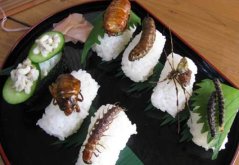Onderwerp scriptie
Production and consumption of novel protein foods: Insects

Topic 1. Extraction and characterization of high quality proteins from insects
To use the insect proteins as a food ingredient, it is necessary to maintain their techno-functional properties. For this, protein extraction from the whole insect under mild extraction conditions is essential to preserve the characteristics of the native protein.
In this research, optimization of extraction and characterization of water-soluble proteins from insects will be investigated. This will be done by setting up an extraction method. Subsequently, the extracted proteins will be characterized with different methods, like Dumas.
For more information on this topic please contact Renske Janssen or Catriona Lakemond.
Topic 2. Healthiness of edible insects: nutrient profiling
Commercial farming, processing and marketing of edible insects are hot issues now because of sustainable potential. In general, the reproduction of insects is less timeconsuming compared to conventional livestock (e.g. pig, cattle). Moreover, a potential shift of human diets from animal meat to insects has beneficial impacts on environment
and ecosystem. Consuming insects could contribute in solving the increasing requirement of high-value protein globally. As a possible replacement of animal protein, edible insects can be progressively served up for human consumption. Consumers like their food to be healthy. Currently there is little insight into overall healthiness of edible insects. In most cases, each insect nutrient was evaluated individually; a healthiness comparison between insects and conventional food groups was neither comprehensive nor systematic. Without powerful nutrition and health claims, consumers have no clear idea about the healthiness of insect-based foods. To help the public make more healthful food choices, the latest American dietary recommendations -2010 Dietary Guidelines for Americans- underlined the use of the nutrient density concept, and approved of nutrient-dense foods and beverages which contributed to achieving and maintaining a healthy weight (USDA and HHS, 2010). In fact, nutrient density deals with the principle of “the amount of nutrients per calorie”. In France, according to the national program on nutrition and health (PNNS), the nutrient density of a food corresponds to its content of essential micronutrients in relation to its energy value. In the United States, according to the United States Department of Agriculture (USDA) and the US Department of Health and Human Services (HHS), nutrient-dense foods offer vitamins, minerals, and other substances that may have positive health effects, with comparatively few calories. Consuming nutrient-dense foods enables people to achieve nutrition goals without exceeding daily energy requirement, which is more beneficial to human health. In this sense, nutrient density can be a good indicator for food healthiness; a higher nutrient density manifests more nutrient-dense and more healthful the food is. In order to assess nutrient density different nutrient profiling systems are used in literature. Nutrient profiling aims at rank ng foods based on their nutrient content as opposite to their energy content. The research will aim at gathering nutrient data of specific insect species, and ranking them for nutrient density using appropriate nutrient profiling systems. Comparisons will be made with traditional and novel protein sources/products. The approach taken will be from a Q-design perspective.
For more information on this topic please contact Catriona Lakemond.